Star Keeper
| Type | single | | Mapper | | | Original mapper | | | PCB marks | 87ARTS BOARD #C1 | | Tags: | | | Uploaded: | 2023-03-18 10:00:28 |
| 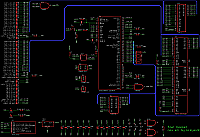 |
Elements:
Chip signature:
27512+74573+7007L (PLCC68)(7007L)+LQFP64STM32F40XXX (LQFP64)(STM32F40XXX)+7408+-(DIL8)+TINY13
PCB top:
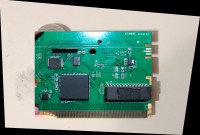
PCB bottom:
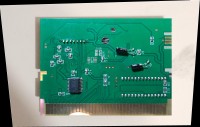
Shell top:
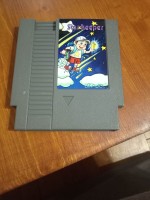
Shell bottom:
No photo
Screenshoots:
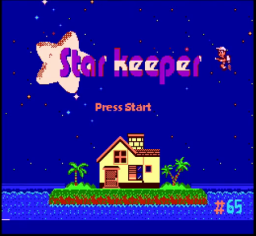
Extra info:
https://forums.nesdev.org/viewtopic.php?t=24523
Star Keeper - analyzing weird homebrew PCB
There is an interesting homebrew game (Star Keeper) that were released in limited quantity (100 pieces).
https://www.videogamesage.com/forums/topic/2383-star-keeper-general-collector%E2%80%99s-discussion/page/12/
https://www.videogamesage.com/forums/topic/12024-about-the-explanation-of-development-authorization-for-star-keeper-branch-version/page/13/
This game looks quite simple
[url=https://obrazki.elektroda.pl/7109824900_1679086674.png][img]https://obrazki.elektroda.pl/7109824900_1679086674_thumb.jpg[/img][/url]
https://www.youtube.com/watch?v=j1EArie7hYo
and I believe it could be just pure NROM game, though the PCB is as usual quite overcomplicated
* There is 32KB EEPROM, no banking. CPU A and D do not go anywhere except EEPROM. Even CPU R/W is not routed anywhere.
* There is no CHR-RAM nor ROM, instead - this huge PLCC68 has all PPU A driven inside. I don't know what drives PPU D because it is hidden under other chip. I was guessing if this is some kind of memory (dual port maybe?) or CPLD, but haven't found anything with at least 8kB RAM that would match the way it is connected:
* GND - pins 35, 52
* +5V - pin 68
* PPU-A0..A12: pins 55..67
* PPU A13 - pin 1
* PPU /WE: pin 5
* PPU /RD: pin 6
* There is LQFP64 that has some common pins shared with the above PLCC68, it also drives CPU /IRQ. I think it's microcontroller.
* GND - pins 18, 25
* 3.3V - pin 64
* /IRQ pin 41
* There is also 6 pin edge connector on the right side of PCB. Maybe this is some kind of programming interface (JTAG? ISP?) for the LQFP64, and the LQFP64 can also program the PLCC68?
* There is small SO14 chip. I can't read its marking, looks like 74HC??D ?
[img]https://obrazki.elektroda.pl/8521386700_1679086635.png[/img]
* On the back side is SO20 chip, marking undreadable.
[img]https://obrazki.elektroda.pl/9980268400_1679086649.png[/img]
The cartridge has CIRAM /CE permanently disabled.
Completely no idea what is goin on, graphic in this game does not look like there is need for mysterious custom video mode being used.
Does not also look like there is some copy protection as no cpu signals go there (though CPU might still read data through $2007 from PPU bus, maybe here is the trick).
(I don't have PCB in my hands, rom is undumped and the coin on the top is not a battery - author of this photo just wanted to hide his number, as every PCB was personalised with unique product number 1..100)
[url=https://obrazki.elektroda.pl/2499658200_1679086683.jpg][img]https://obrazki.elektroda.pl/2499658200_1679086683_thumb.jpg[/img][/url] [url=https://obrazki.elektroda.pl/7282876800_1679086688.jpg][img]https://obrazki.elektroda.pl/7282876800_1679086688_thumb.jpg[/img][/url] [url=https://obrazki.elektroda.pl/6503922100_1679086960.jpg][img]https://obrazki.elektroda.pl/6503922100_1679086960_thumb.jpg[/img][/url] [url=https://obrazki.elektroda.pl/1304153600_1679086961.jpg][img]https://obrazki.elektroda.pl/1304153600_1679086961_thumb.jpg[/img][/url]
---
I found better pictures (especially back side) of this cartridge on the internet. After analzying the connections, I can say that the main game code is stored in this 28 pin EPROM. Nothing else is wired to those pins, so reading back its content (either by desolering or just by using a cartridge dumper) and treating it as NROM (mapper 0) should do the job.
More interesting thing is that there is no RAM/ROM for graphic memory, but the large 68 pin chip is connected to the CHR adddres and data lines. I dont know yet what chip is that (mamory? FPGA?). This smaller 64 chip is also a quite mystery for me (some ARM microcontroller?)
This game looks terribly simple, so existence of such advanced logic is weird, maybe it is some kind of copy proteection scheme.
If you could dump the PRG memory and also read back the markings from those smaller chips, that would be fantastic.
Comments:
Want to leave a comment?






